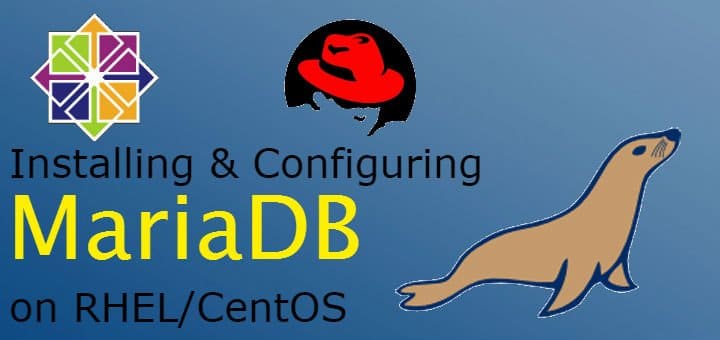MariaDB is an open-source Relational Database & is a community developed forked-out version of the MySQL database. MariaDB has replaced MySQL as the default database in RHEL/CentOS 7. In this tutorial, we are will learn to install & configure MariaDB on CentOS /RHEL 7 machines.
(Recommended Read: MongoDB installation & configuration on RHEL/CentOS)
(Also Read: MariaDB administration commands for beginners)
Install MySQL DB
Starting with RHEL/CentOS 7, MariaDB is available with the default repositories of both the OS. So we can simply install it using yum. To install it, execute the following command from the terminal,
$ yum install mariadb mariadb-server
Once installed, we will start its service & also enable it for boot,
$ systemctl start mariadb
$ systemctl enable mariadb
The database is now running, you can log in to Mariadb by running
$ mysql
in terminal. The default password for root is blank by default which as you can imagine is a serious security threat. So we will now secure our installation.
Configure MariaDB
We will now secure our MariaDB installation by running ‘mysql_secure_installation’ in our terminal. Make sure you read each & every step of the procedure carefully in order to secure your installation,
$ mysql_secure_installation
/usr/bin/mysql_secure_installation: line 379: find_mysql_client: command not found
NOTE: RUNNING ALL PARTS OF THIS SCRIPT IS RECOMMENDED FOR ALL MariaDB
SERVERS IN PRODUCTION USE! PLEASE READ EACH STEP CAREFULLY!
In order to log into MariaDB to secure it, we'll need the current
password for the root user. If you've just installed MariaDB, and
you haven't set the root password yet, the password will be blank,
so you should just press enter here.
Enter current password for root (enter for none):
OK, successfully used password, moving on...
Setting the root password ensures that nobody can log into the MariaDB
root user without the proper authorisation.
Set root password? [Y/n] Y
New password: ROOTPASSWORD
Re-enter new password: ROOTPASSWORD
Password updated successfully!
Reloading privilege tables..
... Success!
By default, a MariaDB installation has an anonymous user, allowing anyone
to log into MariaDB without having to have a user account created for
them. This is intended only for testing, and to make the installation
go a bit smoother. You should remove them before moving into a
production environment.
Remove anonymous users? [Y/n] Y
... Success!
Normally, root should only be allowed to connect from 'localhost'. This
ensures that someone cannot guess at the root password from the network.
Disallow root login remotely? [Y/n] Y
... Success!
By default, MariaDB comes with a database named 'test' that anyone can
access. This is also intended only for testing, and should be removed
before moving into a production environment.
Remove test database and access to it? [Y/n] Y
- Dropping test database...
... Success!
- Removing privileges on test database...
... Success!
Reloading the privilege tables will ensure that all changes made so far
will take effect immediately.
Reload privilege tables now? [Y/n] Y
... Success!
Cleaning up...
All done! If you've completed all of the above steps, yourMariaDB
installation should now be secure.
Thanks for using MariaDB!
That’s it, our Database is now secure & ready to be used. We can now login to our installation by using
$ mysql –u root –p
& can go on to creating new databases, tables, or users.
This was our tutorial on how to install & configure MariaDB on Centos & RHEL 7. If having any queries or issues, please mention them in the comment box down below.
